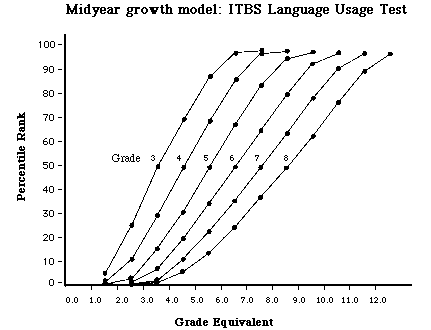|
|
Iowa Test of Basic Skills (ITBS)
|
What is ITBS?
- published by the Riverside Publishing Company
- suitable to Grade K-8 students.
- was normed on the same sample as the Cognitive Abilities test (CogAT), an academic aptitude test.
- determination of aptitude-achievement discrepancies is facilitated when these two tests are used.
- Scores for provided for:
- listening
- word analysis
- vocabulary
- reading
- comprehension
- language
- spelling
- capitalization
- punctutation
- usage
- visual and reference materials
- mathematics
- concpets
- problem solving
- computation
- social studies
- science
- writing and listening supplements
History
- 1931 The Iowa Every-Pupil Tests for high school students were developed at the University of Iowa (UI).
- 1935 The Iowa Every-Pupil Tests were extended to the elementary grades and these batteries were renamed ITBS in 1955
- 1952 The Iowa testing programs are the first to report test results to the parents of elementary school students.
- 1954 UI developd the first electronic scoring machine.
- 1962 The Iowa programs are the first to make frequency distributions and percentiles available.
Reliability and Validity
- Internal consistency and equivalent forms are used
- Of the 84 reliability coefficients (internal consistency) reported for the various subtests, only 6 are in the .70s; the others are in the .80s and .90s. The composite score reliabilities are all .98.
- Research studies are conducted to determine content validity
Characteristis of ITBS
- Scaling test based on both empirical data and extrapolation
- Medians are used for Grade Equilvalent (GE) scores for the robustness of a median against outliers
- Within-grade percentile ranks are used.
- Example: If a fifth grader Tom earns a GE of 8.0, then his percentile rank is over 95 (see Figure below).

Limitations and misinterpretations
- A high GE score does not imply readiness for a higher grade. Rather it means a higher percentile rank.
- GE scores of different subjects cannot be compared.
- GE scores resulting from a scaling procedures depend on the national samples. Can the majority be the "standard"? Is it appropriate to apply GE scores to a local class?
Assignment
Complete the following questions:
- ITBS comes with the reliability and validity information. Which types of reliability and validity are reported in ITBS? What do they mean?
- Why the median instead of the mean is used to set the grade equivalent scores?
- According to the above figure, if a third grader earns a GE of 5.5 in the language usage section of ITBS, what is her approximate percentile rank?
- If the percentile rank of a sixth grader in the math section of ITBS is 50, what is her approximate GE score?
- Tom's percentile rank is 95 and Mary's is 85 in the same ITBS. Tom told Mary that he outperforms Mary a lot. Is it true? Explain.
- John is in seventh grade but his GE score in ITBS is 11.5 and his percentile rank is 99.9. John's parents think that their son outperforms 99.9 percent of all other students, including students from grade 8-11. Is it true? Explain.
- GE scores resulting from a scaling procedures depend on the national samples. Can the majority be the "standard"? Is it appropriate to apply GE scores to a local class? (This is an open end question. There is no right or wrong answer)
|